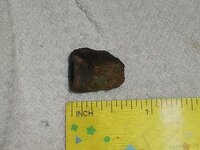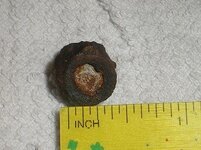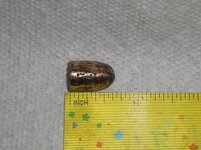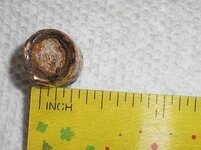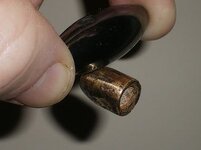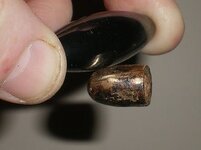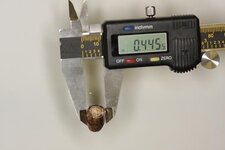
Navigation
Install the app
How to install the app on iOS
Follow along with the video below to see how to install our site as a web app on your home screen.
Note: This feature may not be available in some browsers.
More options
You are using an out of date browser. It may not display this or other websites correctly.
You should upgrade or use an alternative browser.
You should upgrade or use an alternative browser.
bullet help
- Thread starter jefg231
- Start date
TheCannonballGuy
Gold Member
- Feb 24, 2006
- 6,596
- 13,379
- Detector(s) used
- White's 6000, Nautilus DMC-1, Minelab
- Primary Interest:
- Relic Hunting
Looks like a 20th-century "jacketed" bullet. If that is rust on the jacket, it is steel-jacketed rather than the more common copper-jacketed. It appears to be a .44 caliber, for pistol.
Upvote
0
Monty
Gold Member
- Jan 26, 2005
- 10,746
- 166
- Detector(s) used
- ACE 250, Garrett
- Primary Interest:
- All Treasure Hunting
I agree that it look like a .44 bullet that has a true diameter of .429". But what confuses me is that I have never seen a steel jacketed .44 bullet. You need to clean it up a little to really get a true ID. Monty
Upvote
0
TheCannonballGuy
Gold Member
- Feb 24, 2006
- 6,596
- 13,379
- Detector(s) used
- White's 6000, Nautilus DMC-1, Minelab
- Primary Interest:
- Relic Hunting
Cleaned up, the color of your bullet's jacket looks like copper. But the previous photos showed what appeared to be iron/steel rust concretion on it. That is strange. Please try a magnet on it, which will tell us if there's any iron/steel content.
Upvote
0
Monty
Gold Member
- Jan 26, 2005
- 10,746
- 166
- Detector(s) used
- ACE 250, Garrett
- Primary Interest:
- All Treasure Hunting
Wow! That is strange. I know of many steel jacketed bullets during the World Wars, but none of .44 caliber. When copper supplies ran low , steel was substituted, but it was very hard on the bore of the guns. Without the crud I will guess 9mm Luger, WWII era. I think the diameter is larger at the base due to the soft lead core being expanded when fired. But that is just my best guess? Monty
Upvote
0
TiredIron
Sr. Member
Without a caliper measurement and a weight....I'm not sure what cartridge this projectile was loaded in, but I do know that our U.S. Military had both steel core armor piercing 45 ACP ammo and also steel jacketed projectiles that were then copper washed. When fired the weapon's rifling would cut the copper coating and expose the steel jacket.....hence your example had rust on the exterior and once cleaned off appears to be copper left on the surface. This ammunition wasn't manufactured in large quanities or for very long. An accurate weight and diameter measurement would be great.
I believe the Russians and Chinese also produced similar projectiles at some time or another. I know that the Tula Russian Plant has also produced .40 pistol ammo with a copper coated steel FMJ projo....
it would not surprise me if they also produced something in .44.
TiredIron
I believe the Russians and Chinese also produced similar projectiles at some time or another. I know that the Tula Russian Plant has also produced .40 pistol ammo with a copper coated steel FMJ projo....
it would not surprise me if they also produced something in .44.
TiredIron
Upvote
0
TiredIron
Sr. Member
I'm going to out on a limb here and say....I believe your projectile either started out as a 45 ACP pistol round and through oxidation, corrosion, and wear is giving you this measurement. Because of the engraving of the barrel lands....you'll need to rotate the projo and take an average.
Second guess is that it started out as a smaller caliber projectile and through hitting soft dirt or water....it has upset to the slightly larger diameter that you are measuring.
If your curiosity is strong enough....stop by any friendly jewelery store, or Gun Shop and get an actual weight, if not in "grains" we'll do the math. If its #225-230 grains that would support the theory that it is a 45 ACP. With it being as rusty as it was, either steel core or jacketed and the size your measuring.....I'm going to stay with it being a 45 ACP projectile.
Tirediron
Second guess is that it started out as a smaller caliber projectile and through hitting soft dirt or water....it has upset to the slightly larger diameter that you are measuring.
If your curiosity is strong enough....stop by any friendly jewelery store, or Gun Shop and get an actual weight, if not in "grains" we'll do the math. If its #225-230 grains that would support the theory that it is a 45 ACP. With it being as rusty as it was, either steel core or jacketed and the size your measuring.....I'm going to stay with it being a 45 ACP projectile.
Tirediron
Upvote
0
Top Member Reactions
-
 3528
3528 -
 2090
2090 -
 2049
2049 -
 1158
1158 -
 1114
1114 -
 927
927 -
 849
849 -
 823
823 -
 818
818 -
 782
782 -
 770
770 -
 542
542 -
 531
531 -
 453
453 -
 452
452 -
 446
446 -
E
424
-
 413
413 -
 410
410 -
 404
404
Users who are viewing this thread
Total: 2 (members: 0, guests: 2)


